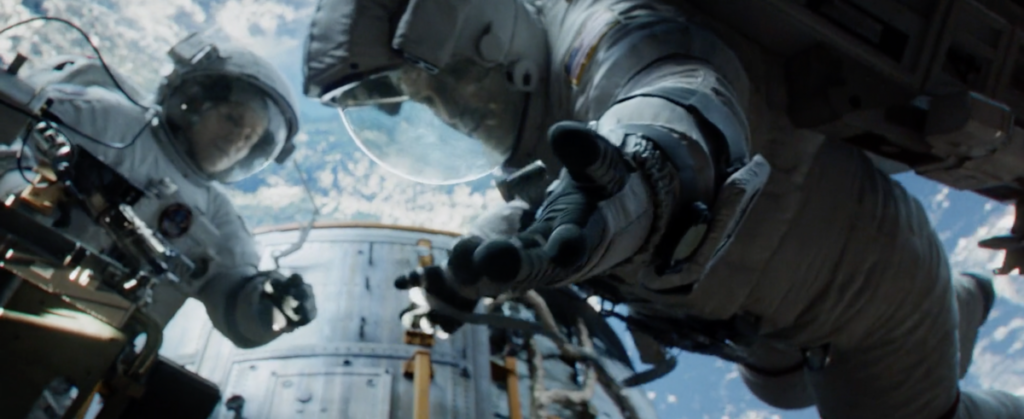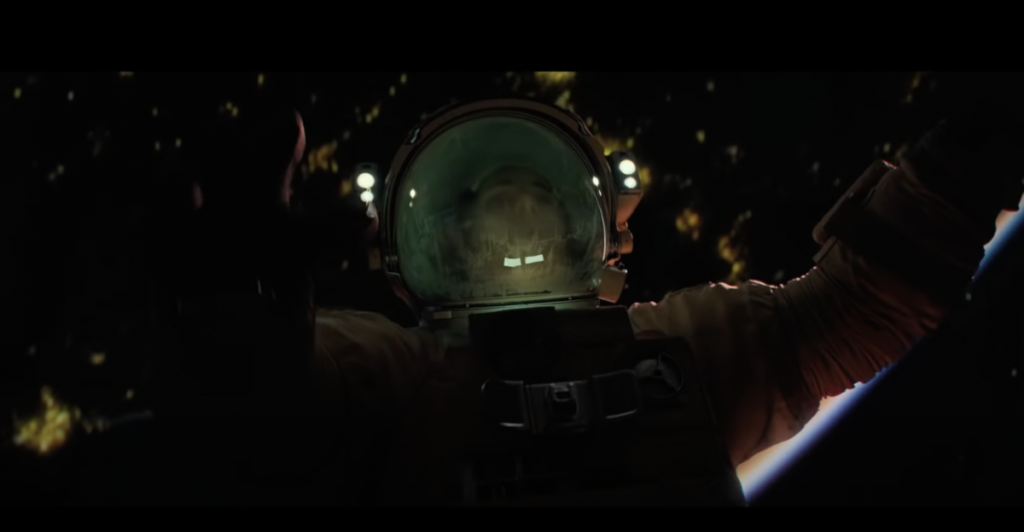In Gravity, director Alfonso Cuarón uses the z-axis and long takes to establish the magnitude of the environment and express pandemonium. The movie begins with a 17-minute long unbroken take. During this take, the camera moves along the typical x and y-axis but also introduces the z-axis, which allows the camera to move under the characters and capture every possible angle. This establishing take assimilates the viewers for the type of camera work yet to come in the film. Not only does Cuarón use the z access, but he highlights it in the first take. A constant mobile frame encircles the characters. This captures the essence of space as it is a free-moving place where direction isn’t limited by the ground or gravity. A sense of overall fear is established from this fact, as it allows the viewer to imagine how easily it is for something to go horribly wrong. This is first represented in the characters holding on tightly to the teathers and Ryan almost dropping a screw into the vacuum of space.

Here, Matt saves the bolt from entering the depth of space. This moment establishes him as a savior in the story and foreshadows how he later saves Ryan from death. This also foreshadows how dangerous the aspect of free-floating is in space, which is what the characters spend a lot of time doing in the film. Cuaron uses a mobile frame to move away from the characters, tracking the screw to emphasize the fear and danger of the scenario. This establishment allows the viewer to become more engaged with the characters’ horror later in the movie when problems arise. Cuaron also uses spinning to convey fear.

This scene has Ryan free floating in space, rapidly spinning. The scene starts with a POV shot of her helmet, displaying her vitals. The idea of her spinning is shown by the earth coming in and out of frame, which gives the viewer a sense of where she is even without a third person shot. The camera the moves to outside her helmet to show her spinning. Cuaron uses continuity between the two angles of inside and outside her helmet to give the audience a duality of views. This captures the emotion of Ryan inside the helmet while also building fear by showing her dire situation from outside the helmet. By using both these angles we can capture 2 senses of Ryan. What she sees and what she is physically feeling, even without actually feeling what she is.
The points raised regarding the story setting up Ryan as a saviour early on are very valid. This is carried on as a narrative theme throughout the story, where one of the few conversations that the characters have between each other is regarding the possible existence of God, the prominent idea of a saviour. Once again is this idea brought up when Stone receives a vision of Matt, who, just like how he saved her mission earlier with the bolt, and then again saves her physical life by sacrificing his own, he mentally rescues Stone by motivating her, saving her “spirit”, so to speak.
It of course begs the question of in a story with only two female characters, Stone and her daughter, they are both portrayed as helpless, with (to put it crudely) Stone’s daughter dying under trivial circumstance, and us getting to witness Matt face the exact same call to death as Stone with drifting into space, but instead face the sentence with grace and humour.
However, the facts that human beings do vary in their anxiety; that it is more interesting to watch a film with both a male and female lead than just both of either; and that it is more interesting to watch a terrified protagonist than a calm one; are all worth considering in evaluating the presence or lack of presence of themes of gender in this film.
Talking more about the shot of the character spinning and the camera spinning along with them, which is not an isolated incident. This has been done on multiple occasions. When the entire crew encounters the flying debris the first time and when Ryan encounters the debris all by herself. I think this 360-degree movement of the camera portrays chaos and stress. I also noted that this is usually accompanied by a zoom-in or a zoom out onto particular objects which get destroyed by the debris.
I think the purpose of this is two-fold, one is to create a sense of involvement for the audience and the second is to shock us when the debris destroys the equipment and spaceships. When we are focusing on a particular detail and it gets destroyed all of a sudden, we are more shocked compared to when something gets hit in the background. As we know from Alfonso Cuaron’s other work such as Children of Men, where he uses 360 shots.
I think the fact that they used Earth as a reference for a lot of spinning shots is essential. This is because in space there are not a lot of reference points that can be used for spinning motion. In a couple of shots, we also saw the reflection of Earth on the helmet of Ryan, this is also an innovative manner to portray the chaos instead of simply using POV shots again and again.
Your analysis of the camera work in “Gravity” highlights several key techniques used by director Alfonso Cuarón to immerse viewers in the film’s environment and convey the magnitude of space and pandemonium.
The introduction of the z-axis, or the third dimension, is indeed a crucial element in the cinematography of “Gravity.” This dimension allows the camera to move under and around the characters, providing a 360-degree perspective of the environment. By doing so, Cuarón establishes the vastness and unpredictability of space. The absence of gravity in space means that danger can come from any direction, and the camera work effectively conveys this sense of vulnerability.
The use of spinning to convey fear and disorientation is another excellent observation. The camera work effectively puts the audience in the character’s shoes, giving them a visceral sense of the chaos and danger surrounding the characters. The use of different angles, including a point-of-view shot inside the helmet and an external view, creates a dual perspective that enhances the emotional impact of the scene.
Your analysis highlights how Alfonso Cuarón’s meticulous use of camera movements serves not only as a technical achievement but also as a storytelling tool. These techniques contribute to the film’s immersive and emotional impact, allowing viewers to experience the vastness, danger, and fear of space alongside the characters.